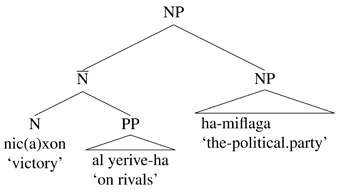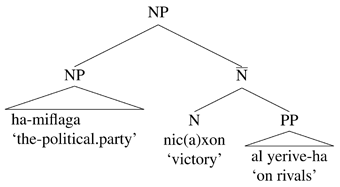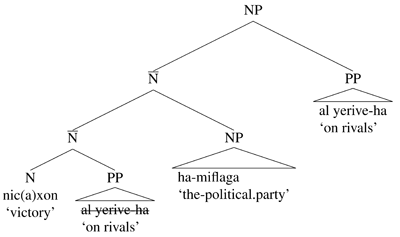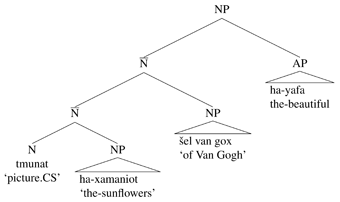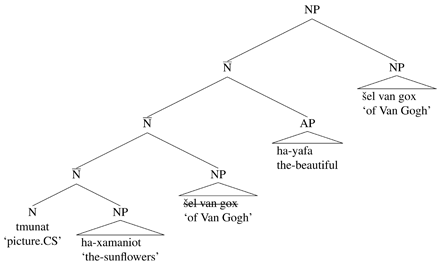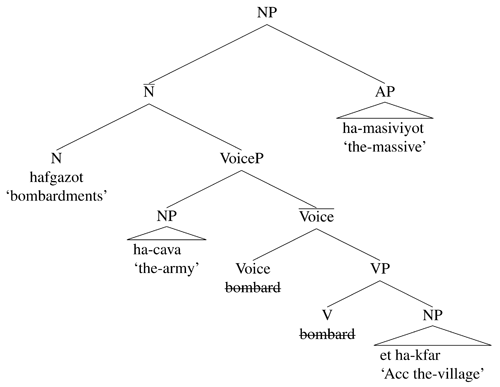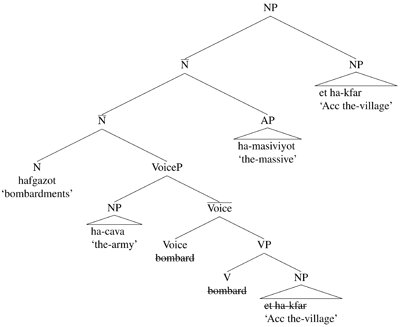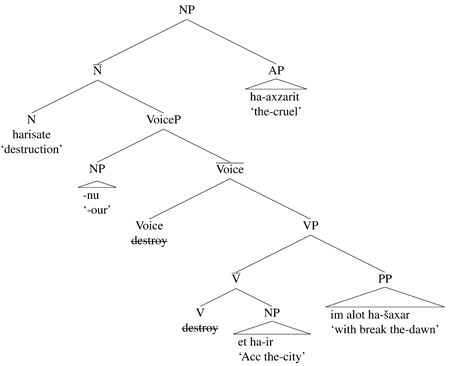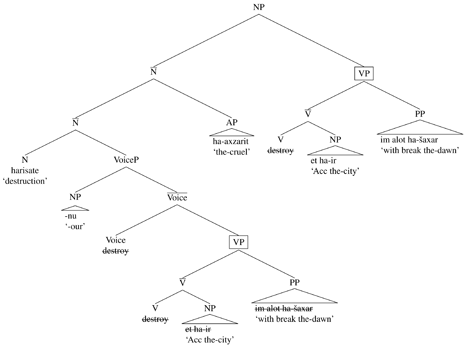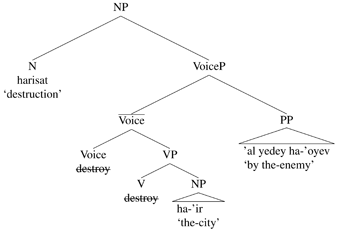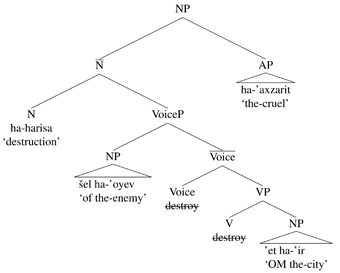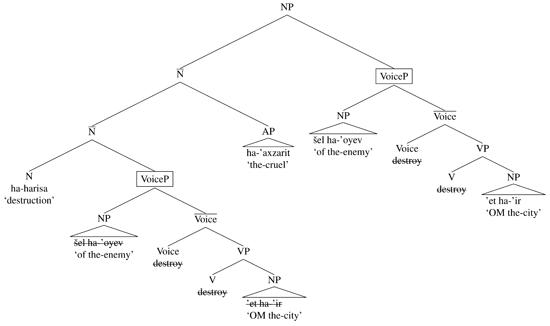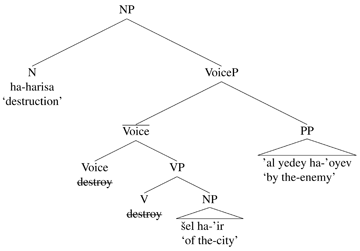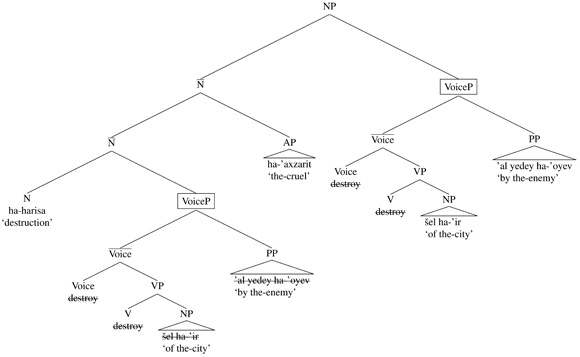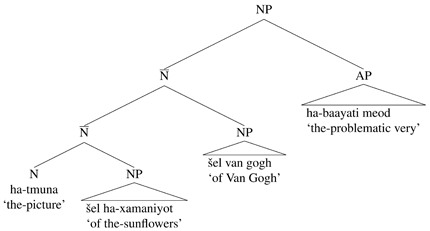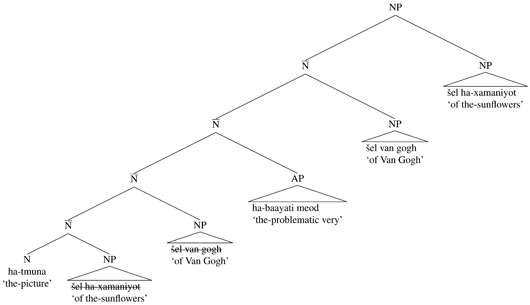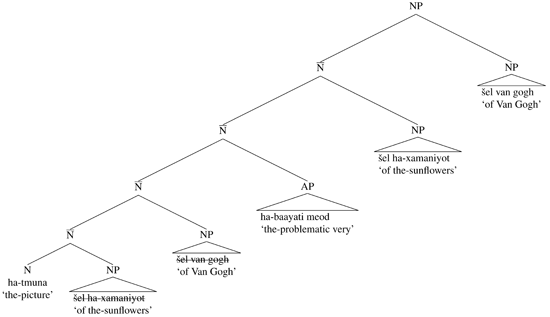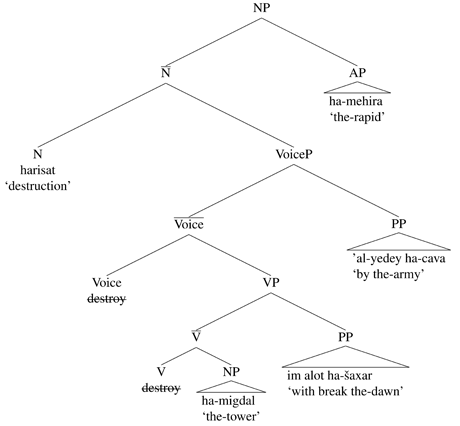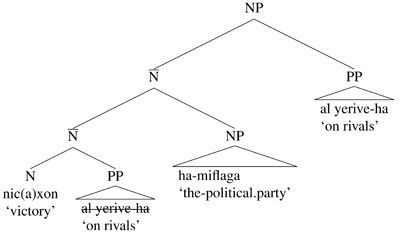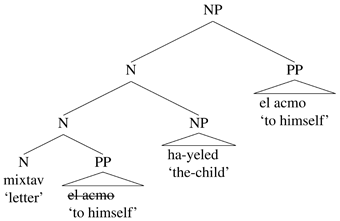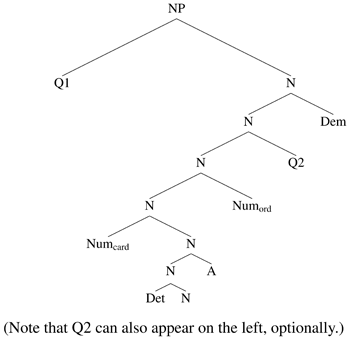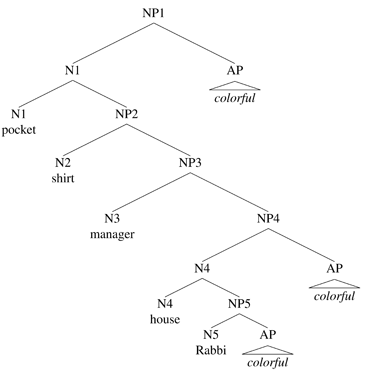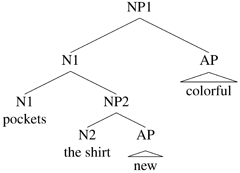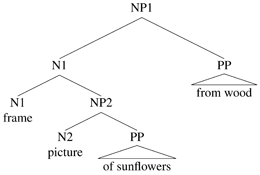1 Introduction: N and its Arguments
Ritter (1991) is widely cited as having shown that Hebrew nominals require functional structure like DP and Num(ber)P dominating the lexical NP. Preminger (2020) illustrates the argument with the following non-derived noun that takes two arguments, an internal one (a PP) and an external one. In such cases, the order is N-S-O (noun-subject-object):1
- (1)
- nic(a)xon
- victory.CS
- ha-miflaga
- the-political.party(F)
- al
- on
- yerive-ha
- rival.Pl.CS-3SgF.Poss
- ‘the victory of the political party over its rivals’ (Preminger 2020: (1a))
(Note that this possessive construction is known as the construct state, “CS” in the gloss; this will be important throughout this paper. The construct state has a head noun, here ‘victory’, followed immediately by a possessor; here the possessor is the external argument of the N, ‘the political party’.)
The assumption behind the argument is that the noun and its internal argument (here the PP) combine first, and then the external argument combines with the constituent that results from that combination. The problem is that no base-generated structure can capture the attested word order on this assumption. I show in (2) two possible base-generation structures that meet this assumption; neither is the correct word order, nor is any other:
- (2)
- a.*
- b.*
The conclusion in the literature is that we need functional structure dominating the NP that sub-constituents within the NP can move to. There are basically two approaches, both of which start with a structure like that in (2b). The first is to posit head movement of N to a higher projection like Num or D (e.g., Ritter 1991). The second is to posit phrasal movement of various types of constituents to the specifiers of higher functional projections (e.g., Sichel 2003; Shlonsky 2004).
In this paper, I revisit the arguments from Hebrew for functional structure above NP like DP and NumP. I show that these arguments are without force. An obvious alternative to an exocentric structure where functional projections embed the lexical NP is an endocentric structure that starts as in (2a), but then has rightward phrasal movement of the internal argument to a position that is still within the NP:
- (3)
This results in the attested NSO word order, and no higher functional structure is necessary. The maximal projection of the nominal is a maximal projection of the head N.2
In fact, a derivation of exactly this sort was proposed by Borer (1999), but only for nouns that are not derived from verbs. She rejects this possibility for deverbal nominals. Other researchers reject it even for non-derived nouns (e.g., Sichel 2003). In this paper, I show that this simple alternative to functional projections plus head or phrasal movement is a viable one, both for underived nouns and deverbal nouns. This means that we do not need functional projections to account for the facts of Hebrew. If functional projections like DP and NumP are not necessary in the analysis of Hebrew nominals, then there is no argument from Hebrew nominals for the existence of functional structure above the lexical NP. The findings of this paper are therefore in line with recent work arguing that the motivation for the DP Hypothesis is lacking, and that the empirical facts actually require that the head of the nominal be the lexical head N (Bruening 2009; 2020; Bruening et al. 2018; see also Salzmann 2020).
I start with the word order facts in derived and underived nouns (section 2), and then turn to binding and scope (section 3). Section 4 discusses some additional facts that analyses with functional projections claim to account for. I show in section 4 that an endocentric analysis is not at a disadvantage in accounting for these facts, and in fact may account for some of them more simply.
I should state at the outset that this study is very limited. It is based almost entirely on already published data, and it does not aim to account for all of the facts of Hebrew nominals, or even most of them. No attempt is made to relate the Hebrew facts to similar (or dissimilar) ones in other languages. The paper seeks only to revisit the arguments that have been given in the literature for the claim that Hebrew requires the postulation of functional projections in the noun phrase. I should also clarify that this paper does not argue against the existence of functional projections in general, or against the existence of head movement. In fact, it proposes analyses where verbal projections have functional structure, and verbal heads undergo head movement. The argument is only that nominals in particular do not involve a series of functional projections where at least one takes the lexical N as its complement and to which the head N may move (as a head, or as a phrase). See Bruening (2009; 2020); Bruening et al. (2018) for arguments that nominals and clauses behave very differently and so motivate this different treatment. The hope is that this study will stimulate research toward explanations of the complete array of facts, in Hebrew and cross-linguistically, within an endocentric model of the NP.
2 Word Order: Deverbal Nominals Versus Underived Nouns
Among the reasons the endocentric analysis I am proposing has not been pursued for Hebrew nominals is an apparently complex array of word order facts. Word order depends on two factors: whether the head noun is a derived one or not, and whether the noun is in the construct state or not. This section shows that these facts are actually compatible with an endocentric analysis of the noun phrase with rightward movement. For ease of exposition, I build the endocentric analysis as I present the facts.
2.1 Non-Derived Construct State Nouns
With non-derived nouns that take arguments, like ‘picture’, only what might be thought of as the internal argument can be the possessor in the construct state, an external argument (or “author”) or possessor may not be (Siloni 1997):
- (4)
- a.
- tmunat
- picture.CS
- ha-xamaniot
- the-sunflowers
- šel
- of
- van
- Van
- gox
- Gogh
- ‘Van Gogh’s picture of the sunflowers’
- b.
- *tmunat
- picture.CS
- van
- Van
- gox
- Gogh
- šel
- of
- ha-xamaniot
- the-sunflowers
Construct state head nouns may not have the definite article and often appear in a special morphological form. They are followed immediately by a possessor, which may have the definite article, or not; the head noun is interpreted as definite if the possessor is. Possessors marked with the preposition šel are not possessors in construct states. In the examples above, only one argument forms the construct with the head noun, the other is a PP headed by the preposition šel. As can be seen, only the internal argument may form the construct with the head noun.
In the construct state, the head noun must be strictly adjacent to the NP it is in construct with. This means that adjectives, for instance, cannot intervene between them. In fact, adjectives that modify the head noun must follow the NP it is in construct with. Additionally, adjectives precede šel phrases, so the following is the only possible order for a modifying adjective:3
- (5)
- tmunat
- picture.CS
- ha-xamaniot
- the-sunflowers
- ha-yafa
- the-beautiful
- šel
- of
- van
- Van
- gox
- Gogh
- ‘Van Gogh’s beautiful picture of the sunflowers’
These facts can easily be accommodated in an endocentric analysis of the noun phrase, where the head N is the head of the nominal. As stated above, I am proposing that the underlying structure of underived nouns is as in (2a), where both complement and specifier of N are on the right. The following shows the analogous structure for a noun like ‘picture’, assuming that the content of the picture is an internal argument and the author is an external argument (ignore the status of šel for the moment):
- (6)
Adjective phrases (APs) adjoin outside of arguments, as shown. To derive the correct word order, the NP marked with šel must obligatorily move rightward, across the AP:
- (7)
I assume that a noun that is in the construct state enters the derivation with a feature [+CS]. This feature has several effects. First, it often has morphophonological effects on the head N: it has a reduced phonological form, the underlying /t/ of the feminine ending is retained, etc. (see, e.g., Siloni 2001: 230). Second, an N with the feature [+CS] must check that feature off. It does so by entering an Agree relation (Chomsky 2000) with an NP that has an unvalued case feature. This Agree relation values the case feature of the NP (as genitive, it is typically assumed) and checks off the [+CS] feature of the head N.
Agree is generally thought to be constrained by locality, such that a head may only Agree with the closest available NP. This is the case in Hebrew, and such a locality constraint will immediately explain the internal argument limitation. First, a head N appears to be able to Agree with any NP that it m-commands (that is, which is dominated by its maximal projection NP). Second, it appears that ‘closest’ is defined in terms of number of segments separating the head noun from an eligible NP. In (7), the NP ‘the sunflowers’ is separated from the head noun by two segments, while the NP ‘Van Gogh’ is separated from it by three (in its base position). We can then formalize the locality constraint on Agree as follows:
- (8)
- Locality Constraint on Agree
- A head α with maximal projection αP can only Agree with an NP A if αP dominates A and there is no eligible NP B dominated by αP such that B is separated from α by fewer segments than A.
This kind of locality constraint is what we see in numerous areas of syntax, and so it is not surprising. It or one like it is widely assumed to constrain the operation of Agree (Chomsky 2000 and numerous others). If a head noun can only form the construct with the closest NP in its projection, then the presence of an internal argument will always block an external argument from forming the construct with an underived noun. This accounts for why only the internal argument and not the external one may form a construct state with the head noun.
As for the element šel on the NP that is not in construct with the head N, I will assume that Ns can iteratively case-license NPs within their maximal projection and that they are not in construct with. NPs case-licensed by N in this manner are marked morphologically with šel. We can model this with the same Agree relation. Any N, whether [+CS] or not, may enter into an Agree relation with an NP that it m-commands, and this Agree relation may apply iteratively (once the closest NP has had its case feature valued, it is no longer an intervener for a subsequent application of Agree, since it no longer has an unvalued case feature and is therefore not eligible for Agree). If an N has a [+CS] feature, however, this feature must be checked first, and it can be checked only once. An Agree relation that checks the [+CS] feature does not result in the appearance of šel, while all others do. (I assume that case-licensing with šel can apply iteratively precisely because it does not check off any feature on the head N.)
So, after the [+CS] head N Agrees with the closest NP and forms a construct state with it, it then enters into a subsequent Agree relation with the other NP. This case-licenses that NP, with the morphological reflex šel.
As for the word order with respect to adjectives, the NP marked with šel must move rightward across the AP, while the NP that is in construct with the head noun must not. I will start with the latter.
There is a strict adjacency requirement on the construct state, such that the head noun must be strictly adjacent to the NP it is in construct with. There are many proposals in the literature for how to model this strict adjacency. Many stipulate an adjacency requirement on case assignment (e.g., Ritter 1991). Others suggest that the construct head noun and the NP it is in construct with form a morphological or syntactic word (e.g., Benmamoun 2000). Borer (1999) proposes that the head of the possessor NP incorporates into the head N. Siloni (2001) gives arguments against syntactic or morphological wordhood accounts, as well as against incorporation (e.g., the coordination in (10)). The most promising account appears to be the prosodic one of Siloni (2001), which I will adopt here. According to Siloni (2001), the head N must form a prosodic unit (namely, a prosodic word) with (at least part of) the NP it is in construct with. This seems to be descriptively accurate, as the head N is in a reduced phonological form and clearly forms a prosodic unit with the NP it is in construct with (for stress, e.g.). Siloni (2001) proposes that forming a prosodic word is necessary for case checking, but this is not something that I will explore in any detail. All that is necessary here is the recognition that there is a prosodic constraint on the construct state, perhaps along the lines of the following:
- (9)
- Prosodic Constraint on the Construct State:
- A [+CS] N must form a prosodic word with phonological material dominated by the NP that checks its [+CS] feature.
For instance, in the following example where a head N is in construct with a coordination of NPs, the head N must form a prosodic word with the leftmost part of that coordination (so that (ω bdikat mizvadot) forms a prosodic word4):
- (10)
- bdikat
- examination
- mizvadot
- suitcases
- ve-tikim
- and-bags
- ‘examination of suitcases and bags’ (Siloni 2001: 232, (3a))
Importantly for our concern (word order), the constraint in (9) will prevent the head N and the NP it is in construct with from being separated by adjectives (or any other material that is incapable of appearing in the middle of a prosodic word).
As for movement of the šel phrase to the right of the AP, šel phrases are not subject to a prosodic constraint of this sort. There is therefore nothing that prevents them from moving rightward. As for why they have to, Siloni (2001: 240–241) presents some evidence indicating that the motivation for this movement might be prosodic, as well. According to Siloni (2001), there can be no prosodic word intervening between an AP and the right edge of the N it modifies (except another AP, and the possessor in the construct state). If this is correct, then arguments of the head N must move rightward across the AP, in order for the AP to meet its prosodic requirements. The exception is an argument that the head N is in construct with, because they must form a prosodic word together. The effect on the syntax is that anything other than the NP a head N is in construct with must move rightward across an AP that modifies that N.5 In what follows, I will be exploring this rightward movement in more detail.
To summarize so far, we have built an analysis of the construct state, of case-licensing of šel phrases, and the motivation for strict adjacency in the construct but movement of šel phrases across adjectives. The analysis also explains why only the internal argument of a non-derived noun can form the construct, while other arguments or possessors must be marked as šel phrases.
2.2 Derived Construct State Nouns
In contrast with non-derived nouns, nouns that are derived from transitive verbs can only form the construct with the logical external argument, and not with the logical internal argument:
- (11)
- a.
- harisat
- destruction
- ha-’oyev
- the-enemy
- ‘et
- OM
- ha-ir
- the-city
- ‘the enemy’s destruction of the city’
- b.
- *harisat
- destruction
- ha-’ir
- the-city
- šel
- of
- ha-oyev
- the-enemy
The logical internal argument is marked with accusative case (glossed “OM” by Borer 1999), like the object of a verb. The logical external argument is the possessor in the construct state, and must be strictly adjacent to the head noun.
The logical external argument of a derived noun can also appear as a by-phrase, as in a passive, in which case the logical internal argument does form a construct state with the head noun (and is not marked with accusative case):
- (12)
- harisat
- destruction
- ha-’ir
- the-city
- (‘al yedey
- (by
- ha-’oyev)
- the-enemy)
- ‘the destruction of the city by the enemy’ (Borer 1999: 57, (45b))
The logical external argument can also be left out, and in this case, the logical internal argument can also form a construct state with the head noun.
Additionally, adjectives that modify the head noun must immediately follow whatever NP the N is in construct with, any other word order is ungrammatical:
- a.
- hafgazot
- bombardments
- ha-cava
- the-army
- ha-masiviyot
- the-massive
- et
- Acc
- ha-kfar
- the-village
- ‘the massive bombardments of the village by the army’
- b.
- *hafgazot
- bombardments
- ha-cava
- the-army
- ‘et
- Acc
- ha-kfar
- the-village
- ha-masiviyot
- the-massive
- ‘the massive bombardments of the village by the army’
According to Siloni (1997: 37–38), this placement of the adjective follows from an exocentric analysis of the NP: the deverbal N raises to D across the AP, and the external argument also raises to the left across AP, while the internal argument stays low.
However, we do not need an exocentric analysis of the NP in order to derive this word order, as I will now show. First, we do need a minimal analysis of nouns derived from verbs. I will follow Hazout (1995); Borer (2013) in taking Hebrew deverbal Ns to embed a verbal projection. I will adopt the specific analysis of Bruening (2013), according to which deverbal nouns have a nominalizing head N which embeds a full VoiceP, where Voice is the head that projects the external argument (Kratzer 1996). This yields a structure like the following for a nominal like ‘the army’s massive bombardments of the village’ (13a):6
- (14)
Any AP that modifies the head N will adjoin to the right, as shown.
In contrast with NPs, VoiceP has the specifier on the left (subjects are on the left in clauses in Hebrew). Also in contrast with NPs, head movement does occur here, from V to Voice to N (but no further, there is no head movement of N to anywhere else). This movement, plus the same movement to the right across an AP, suffices to derive the word order of a derived N in the construct state. The same constraint we posited before, stating that a [+CS] head N can only form a construct (Agree) with the closest NP (8), requires that the NP in Spec-VoiceP, and not that inside VP, form a construct with the derived head noun. The NP in Spec-VoiceP is separated from N by three segments, while the NP inside VP is separated from it by five. This structure also includes active Voice (a Voice head which projects an NP specifier), which I assume licenses accusative case on the object. Voice case-licenses the NP inside VP (by Agree again7), resulting in it being marked with the accusative case marker ‘et.8 The NP inside VP cannot be marked with šel instead, because Voice will have case-marked it by the time the derivation reaches N. At that point, the NP is already case-marked, so there is no need for N to Agree with it. N therefore cannot, by general economy considerations.
As stated in the previous section, there is a constraint (possibly prosodic) on modifying adjectives that has the result that any phrase that is not in construct with the head noun has to move rightward across the AP. In the current case, the external argument does not move, since it is in construct with the N, while the internal argument does. This results in the attested word order:
- (15)
So far, then, we have accounted for the differences between derived and non-derived nouns in the construct without any functional projections above N, and without head or phrasal movement of N. All we need is a locality constraint on which NP is permitted to Agree with a [+CS] N and thereby form a construct with it, something that is going to be necessary in any case, plus obligatory rightward movement of non-construct phrases across modifying APs.
As might be expected given the constraint on modifying adjectives, other intervening material has to move, too. Hazout (1995) gives the following example, where both the internal argument and an adjunct PP have to move rightward across the adjective:
- (16)
- a.
- harisate-nu
- destruction-our
- ha-axzarit
- the-cruel
- et
- Acc
- ha-ir
- the-city
- im
- with
- alot
- break
- ha-šaxar
- the-dawn
- ‘our cruel destruction of the city with the break of dawn’
- b.
- *harisate-nu
- destruction-our
- im
- with
- alot
- break
- ha-šaxar
- the-dawn
- et
- Acc
- ha-ir
- the-city
- ha-axzarit
- the-cruel
This example has a pronominal possessor as the external argument. Pronominal possessors form construct states with the head noun (see, e.g., Siloni 1997: 54–59). I will assume that the pronoun starts in Spec-VoiceP, but will not develop an analysis of how it surfaces as a pronominal clitic on the head noun (it might do so simply in virtue of forming a prosodic word with it, just like any NP in the construct). I assume the adjunct PP modifies VP:
- (17)
In this case, the NP and the PP could move independently across the AP, in two instances of movement. Alternatively, the entire (remnant) VP could move. I assume that the latter is what happens, since the grammar prefers to satisfy constraints using the fewest operations possible. In this case the constraint requires that all phonological material get out from between the prosodic word of the head noun and the modifying adjective. Movement of a single constituent, namely VP, will accomplish this:
- (18)
The result is that material that moves across modifying adjectives retains its base order.
As for derived Ns with by-phrases as in (12), I again adopt the structure proposed by Bruening (2013: 32, (103)), where the nominalizing head N can combine with a projection of Voice where an adjunct by-phrase has saturated the semantic argument of Voice (see Bruening 2013 for details of how by-phrases work):
- (19)
What Borer (1999) glosses as “OM”, the morpheme ‘et, I take to be accusative case, licensed only by active Voice (one that projects an NP specifier); accordingly, this morpheme is not present in a non-active nominal like this. Instead, I assume that it is the head N that licenses the object, by virtue of forming a construct state with it. It is allowed to do so, given the locality constraint, because the external argument is an adjunct PP, not an argument NP, and so it is not an eligible NP for Agree. PPs may not form construct states with Ns, and they also do not in general Agree. The closest NP to the N head is then the internal argument inside VP.
It is important to point out that nominalizations with by-phrases are not passives in this analysis. In the analysis of by-phrases in Bruening (2013), verbal passives have a head, Pass, which is responsible for the morphology and (some aspects of) the interpretation of passives. This head is not present in nominalizations. Instead it is the head N that licenses a by-phrase or an implicit external argument. This is important because Hazout (1995), Siloni (1997: 89), and Siloni & Preminger (2009) have pointed out several differences between nominalizations and verbal passives in Hebrew. The most prominent one is that an implicit external argument is obligatorily human in nominalizations but not in verbal passives. This is easy to account for in the analysis of Bruening (2013): In verbal passives, the head Pass existentially binds the missing argument, but in nominalizations, the head N instead projects it, as a silent PRO (Bruening 2013: 31, (102)). This PRO apparently must be human in some languages, like Hebrew (but not others, like English).
As for adjectives, the same constraint as before will force the by-phrase, if present, to move rightward across any AP:
- (20)
- ?harisat
- destruction
- ha-migdal
- the-tower
- ha-mehira
- the-rapid
- ‘al-yedey
- by
- ha-cava
- the-army
- ‘the rapid destruction of the tower by the army’ (Siloni 1997: 52, (60))
The internal argument will not undergo this movement, because it is in construct with the head N and forms a prosodic word with it (see above). The result is again that APs immediately follow the NP that is in construct with the head N but precede all other constituents.
2.3 Derived Free State Nouns
In the free state, all NP arguments and possessors are introduced by the morpheme šel, typically glossed as ‘of’ in the literature. Derived nominals in the free state again have an “active” and a “passive” variant. The “active” has the external argument introduced by šel, while the internal argument is marked with accusative case (‘OM’, in Borer’s glossing). The external argument must come first:
- a.
- ha-harisa
- the-destruction
- šel
- of
- ha-oyev
- the-enemy
- ‘et
- OM
- ha-’ir
- the-city
- b.
- *ha-harisa
- the-destruction
- ‘et
- OM
- ha-’ir
- the-city
- šel
- of
- ha-oyev
- the-enemy
- c.
- *ha-harisa
- the-destruction
- šel
- of
- ha-’ir
- the-city
- ‘et
- OM
- ha-oyev
- the-enemy
- d.
- *ha-harisa
- the-destruction
- šel
- of
- ha-’ir
- the-city
- šel
- of
- ha-oyev
- the-enemy
The “passive” variant has the external argument introduced by a by-phrase; now the internal argument must come first, marked with šel:
- (22)
- a.
- ha-harisa
- the-destruction
- šel
- of
- ha-’ir
- the-city
- ‘al yedey
- by
- ha-’oyev
- the-enemy
- b.
- *ha-harisa
- the-destruction
- ‘al yedey
- by
- ha-’oyev
- the-enemy
- šel
- of
- ha-’ir
- the-city
- c.
- *ha-harisa
- the-destruction
- šel
- of
- ha-’oyev
- the-enemy
- ‘al yedey
- by
- ha-’ir
- the-city
As expected given the constraint identified earlier, adjectives must come immediately after the head noun, before both the subject and the object:
- (23)
- ha-harisa
- the-destruction
- ha-’axzarit
- the-cruel
- šel
- of
- ha-’oyev
- the-enemy
- ha-xamuš
- the-armed
- ‘et
- Acc
- ha-’ir
- the-city
- ‘the cruel destruction of the city by the armed enemy’ (Borer 1999: 51, (29a))
- (24)
- a.
- ha-axila
- the-eating
- ha-menumeset
- the-polite
- šel
- of
- dan
- Dan
- et
- Acc
- ha-uga
- the-cake
- ‘Dan’s polite eating of the cake’
- b.
- *ha-axila
- the-eating
- šel
- of
- dan
- Dan
- ha-menumeset
- the-polite
- et
- Acc
- ha-uga
- the-cake
- ‘Dan’s polite eating of the cake’
We can account for these facts without adding anything to the analysis. First, derived nouns embed a VoiceP, as before. The active variant has the internal argument as sister to V, and the external argument in Spec-VoiceP:
- (25)
Also as before, the V moves to Voice and then to N. Active Voice (one that projects an NP specifier) assigns accusative case to the internal argument, realized as ‘et. The NP in Spec-VoiceP is not case-licensed within VoiceP (in a clause, it would be case-licensed by T), so it must be case-licensed by N, via Agree, which results in it being marked morphologically with šel (since this N is not [+CS]).
The constraint identified before, which says that adjectives must be adjacent to the prosodic word that contains the noun they modify, forces movement of both the subject and the object across AP to adjoin to NP on the right. They could each move, independently, but in this case, as before, there is a simpler way to satisfy the constraint stating that the AP needs to be adjacent to the head noun. This is to move the entire remnant VoiceP:
- (26)
The result is the attested word order, where the adjective follows the head noun and the two arguments have maintained their linear order to its right.
As stated above, constraints are always satisfied in the minimal way possible, using as few operations as possible. In this case, a single movement of the remnant VoiceP will move all phonological material out of the way between the head N and the AP. This is more minimal than moving each argument independently (two instances of phrasal movement versus one). We therefore expect that all material in the VoiceP will maintain its original order to the right of the adjective, and this seems to be correct. PP adjuncts follow arguments (Borer glosses be mehirut as an adverb ‘quickly’, but it is actually a prepositional phrase, ‘with quickness’):
- (27)
- a.
- ha-’axila
- the-eating
- šel
- of
- Dan
- Dan
- ‘et
- OM
- ha-tapu’ax
- the-apple
- be mehirut
- quickly
- b.
- ?*ha-’axila
- the-eating
- šel
- of
- Dan
- Dan
- be mehirut
- quickly
- ‘et
- OM
- ha-tapu’ax
- the-apple
The predicted word order when there is also an adjective is the same relative order of arguments and adjuncts, since it is the entire remnant VoiceP that moves. This is correct:9
- (28)
- ha-’axila
- the-eating
- ha-menumeset
- the-polite
- šel
- of
- Dan
- Dan
- ‘et
- Acc
- ha-tapu’ax
- the-apple
- be
- with
- mehirut
- quickness
- ka-zot
- such
- ‘Dan’s polite eating of the apple so quickly’
The “passive” variant again has an adjunct by-phrase adjoined to a projection of Voice (again this is not truly a passive, since it lacks the head Pass):
- (29)
The by-phrase is a PP adjunct, and so does not interact in Agree. The internal argument is not case-licensed, since only active Voice Agrees with and case-licenses an object. A Voice that does not project an external argument in its specifier does not Agree with and case-license an object. The internal argument therefore has to be case-licensed by the head N, via Agree, which results in it being morphologically marked with šel (since the head N is not [+CS]). As for word order, the internal argument and the by-phrase cannot reverse their order. If an adjective is present, the entire remnant VoiceP will again move across the adjective:10
- (30)
- ha-harisa
- the-destruction
- ha-’axzarit
- the-cruel
- šel
- of
- ha-’ir
- the-city
- ‘al yedey
- by
- ha-’oyev
- the-enemy
- ‘the cruel destruction of the city by the enemy’
- (31)
2.4 Non-Derived Free State Nouns
With non-derived nouns, the order of šel phrases is free, according to Shlonsky (1988) and Borer (1999):
- (32)
- a.
- ha-tmuna
- the-picture
- šel
- of
- van
- Van
- gogh
- Gogh
- šel
- of
- ha-xamaniyot
- the-sunflowers
- b.
- ha-tmuna
- the-picture
- šel
- of
- ha-xamaniyot
- the-sunflowers
- šel
- of
- van
- Van
- gogh
- Gogh
If there is a modifying adjective, it must immediately follow N, and precede all šel phrases. I have been unable to find examples of this sort in the literature, but the following were provided by an anonymous reviewer (he or she does not give a grammatical instance with an adjective and two šel phrases, but I assume the adjective would precede both):
- (33)
- a.
- ha-ciyur
- the-painting
- ha-baayati
- the-problematic
- meod
- very
- šel
- of
- ha-xamaniot
- the-sunflowers
- ‘the very problematic painting of the sunflowers’
- b.
- ha-ciyur
- the-painting
- ha-baayati
- the-problematic
- meod
- very
- šel
- of
- van
- Van
- gogh
- Gogh
- ‘Van Gogh’s very problematic painting’
- c.
- *ha-ciyur
- the-painting
- šel
- of
- ha-xamaniot
- the-sunflowers
- ha-baayati
- the-problematic
- meod
- very
- šel
- of
- van
- Van
- gogh
- Gogh
- ‘Van Gogh’s very problematic painting of the sunflowers’
- d.
- *ha-ciyur
- the-painting
- šel
- of
- van
- Van
- gogh
- Gogh
- ha-baayati
- the-problematic
- meod
- very
- šel
- of
- ha-xamaniot
- the-sunflowers
- ‘Van Gogh’s very problematic painting of the sunflowers’
Nothing needs to be added to the analysis to explain these facts. First, both arguments are projected on the right, as before, with the internal argument merging first, followed by the external argument:
- (34)
APs adjoin higher, on the right, as shown.
Since the head N here is not [+CS], any NP that it m-commands will be marked with šel. The N Agrees first with the closest NP, the internal argument, and then with the further NP, the external argument. Both are marked with šel.
Now, the constraint on modifying adjectives will force movement of all phonological material between the adjective and the head noun. In this case, this cannot be accomplished with a single step of movement. In (34), there is no constituent that includes all and only the two NPs. The grammar is then forced to satisfy the constraint by doing two separate instances of movement. I assume that it can perform the two instances of movement in either order. In the first order, the higher argument moves first, and then the lower one moves and adjoins above it:
- (35)
In the second order, the lower argument moves first, and then the higher one moves and adjoins above it:
- (36)
If there is no adjective, as in (32), I assume that an optional reordering process permits the lower argument to move across the higher. So long as no constraints are violated, this is allowed. According to Siloni (1997: 101), many speakers find the order N-S-O in (32a) marginal, while an intonational break improves it. In the current analysis, we can account for these speakers by saying that they have a very strong preference for maintaining the underlying order (note that order preservation is the typical case for all other nominals in Hebrew). In the absence of an adjective motivating movement, this manifests as a general dispreference for moving the lower NP across the higher one.
To summarize so far, the endocentric analysis has no problem accounting for the complex word order facts found in Hebrew nominals. All we need is minimal analyses of deverbal and non-derived nouns, case-licensing via Agree, and the construct state, which are things we need anyway. In addition, we need rightward movement across adjectives. There is no need for functional projections like NumP and DP dominating the lexical NP in order to account for the word order of nominals in Hebrew.
2.5 A Prediction: Free Word Order
The account proposed here makes a prediction (pointed out by a reviewer). In sections 2.2 and 2.3, we saw that word order after an adjective with derived nouns was fixed. This resulted from the fact that a single instance of movement, of either VP or VoiceP, could satisfy the prosodic requirement of an adjective. Moving VP or VoiceP preserved the base order of the material undergoing the movement. In contrast, in section 2.4, when two elements had to undergo movement across an adjective separately, they could move in any order, yielding free order after the adjective. Suppose we now have a derived noun with a by-phrase, so that the internal argument forms the construct state with the derived noun. The internal argument is very low, sister to V. Since it forms the construct with the head noun, no larger constituent like VP or VoiceP could move other elements within VoiceP across an adjective in a single step. We therefore predict free word order after the adjective. This seems to be correct, and both of the following word orders are acceptable (Itai Bassi, p.c.):
- (37)
- a.
- harisat
- destruction
- ha-migdal
- the-tower
- ha-mehira
- the-rapid
- ‘al-yedey
- by
- ha-cava
- the-army
- im
- with
- a lot
- break
- ha-šaxar
- the-dawn
- ‘the rapid destruction of the tower by the army with the break of dawn’
- b.
- harisat
- destruction
- ha-migdal
- the-tower
- ha-mehira
- the-rapid
- im
- with
- alot
- break
- ha-šaxar
- the-dawn
- ‘al-yedey
- by
- ha-cava
- the-army
- ‘the rapid destruction of the tower by the army with the break of dawn’
The following diagram illustrates the structure prior to movement in the proposed analysis. Once again I assume that ‘with the break of dawn’ is adjoined to VP, while the by-phrase is adjoined to VoiceP. Since the sister of V forms the construct with the head N, there is no single constituent that can move both PPs across the adjective. The PPs have to move separately, and this results in free word order after the adjective.
- (38)
I take this correct prediction to support the proposed account.
2.6 Combining the Construct and a PP with šel
Derived and non-derived nouns also differ in their ability to combine the construct state with an NP marked with šel. Derived nouns cannot. As described in section 2.2, there are only two options for derived nouns in the construct state, an “active” one and a “passive” one. In neither of those options is one of the arguments marked with šel (in the active, the internal argument is marked with Acc, in the passive, the external argument is a by-phrase). In contrast, non-derived nouns can combine an NP in the construct with another NP marked with šel, as we saw in section 2.1:
- (39)
- tmunat
- picture.CS
- ha-xamaniot
- the-sunflowers
- šel
- of
- van
- Van
- gox
- Gogh
- ‘Van Gogh’s picture of the sunflowers’ (Sichel 2003: 450, (4))
This contrast also follows in the proposed account. As explained in section 2.2, there is only one derivation that converges for each of the active and passive variants of derived nouns. In the active, only the external argument can form the construct with the head noun, because of locality, while the internal argument is case-licensed by Voice, leading it to be marked with ‘et, not šel. In the passive, only the internal argument can form the construct with the head noun, because the by-phrase is not eligible. The by-phrase is also ineligible for case-licensing by N.
In contrast, in a non-derived nominal like that in (39), only one NP can form the construct with the head noun, because the first instance of Agree will check off the [+CS] feature. However, the other still needs to be case-licensed by N and so gets marked with šel. In terms of feature checking and Agree, the N ‘picture’ enters the derivation with a [+CS] feature. It has to Agree with an eligible NP in order to check this feature. The closest NP is ‘the sunflowers’, so the N Agrees with this NP. This checks off the [+CS] feature of the head N and case-licenses the NP ‘the sunflowers’, with all of the effects of the construct state. The other NP, van gox, still needs to be case-licensed. The head N enters into a second Agree relation. The internal argument has had its case feature valued, so it no longer intervenes, and the head N can Agree with the NP van gox. Because the N no longer has the feature [+CS], this Agree relation results in van gox being marked with šel.
2.7 Rightward Movement of PPs
Let us return to the example in (1), repeated below:11
- (40)
- nic(a)xon
- victory.CS
- ha-miflaga
- the-political.party(F)
- al
- on
- yerive-ha
- rival.Pl.CS-3SgF.Poss
- ‘the victory of the political party over its rivals’ (Preminger 2020: (1a))
To account for the word order, I proposed rightward movement within the NP:
- (41)
This rightward movement is not the same as the obligatory rightward movement across adjectives that we have seen throughout this section. There is no adjective here. Yet this rightward movement also seems to be obligatory:
- (42)
- *nic(a)xon
- the-victory.CS
- al
- on
- mančester
- Manchester
- liverpul
- Liverpool
- ‘the victory of Liverpool over Manchester’ (Preminger 2020: 6, (11b))
The reason for this is that the head noun has the [+CS] feature. This means it needs to Agree with an NP with an unvalued case feature, and in doing so value its case feature and check off the [+CS] feature on the head noun. In (41), the NP inside the PP is not eligible for Agree (NPs inside PPs are never eligible for Agree). The only NP the N can Agree with is then the logical external argument, ‘the political party’. N therefore Agrees with this NP, case-licensing it and checking off the [+CS] feature on N.
Now, recall that there is a prosodic condition constraining the construct state, repeated below from (9):
- (43)
- (=9) Prosodic Constraint on the Construct State:
- A [+CS] N must form a prosodic word with phonological material dominated by the NP that checks its [+CS] feature.
In (41), this constraint will be violated if the PP does not move. If the PP does not move, general principles of prosody in Hebrew will put at least one prosodic word boundary between the head N and the NP that checks its [+CS] feature (after the complement of the P). The PP is therefore forced to move, in order to satisfy (9).
In contrast, if the N is not [+CS] and it licenses its NP argument with šel instead, movement (and thereby NSO order) is not obligatory:
- (44)
- a.
- ha-nicaxon
- the-victory.NCS
- šel
- of
- liverpul
- Liverpool
- al
- on
- mančester
- Manchester
- ‘the victory of Liverpool over Manchester’
- b.
- ?ha-nicaxon
- the-victory.NCS
- al
- on
- mančester
- Manchester
- šel
- of
- liverpul
- Liverpool
- ‘the victory of Liverpool over Manchester’
Movement of the PP is allowed, but it is not obligatory, since (9) does not govern non-construct nouns. (Movement of the PP does seem to be preferred.)
We have now successfully analyzed all of the data on word order in Hebrew nominals, without the need for exocentric structure. The head of the nominal can be N, with no need for NumP or DP dominating NP. All we need is rightward movement, which seems to be motivated by prosodic requirements (of the construct state, and of adjectives).
2.8 Non-Nominal Constructs
Analyses of the Hebrew nominal that posit NumP and DP dominating NP (and often more projections) have as a crucial part of their analysis of the construct state movement of N to D (either head movement, or phrasal movement). The current analysis does not. It is therefore significant that Siloni (2002) showed that non-nominal categories like adjectives can also form the construct. Below is an example:
- (45)
- zo
- this
- dira
- apartment
- rexavat
- wide(FS)
- xalonot.
- windows
- ‘This is an apartment with wide windows.’ (Siloni 2002: 167, (15b))
The phrase rexavat xalonot is a construct, ‘wide of windows’. As Siloni (2002) shows, adjectival constructs like this have all of the properties of construct states: the head adjective is in the special construct form (here, with the underlying /t/ of the feminine singular pronounced), it cannot have the definite article, it is obligatorily adjacent to the NP it is in construct with, etc. Yet the head is not a noun, it is an adjective, and the entire construct has the distribution of an AP (here it is a postnominal modifying AP).
As Siloni (2002) argues, analyses of the construct state that include N to D movement (head or phrasal) as a crucial part cannot be extended to non-nominal constructs like this. In an AP, the head is not an N, and there is no D for it to move to.
In contrast, in the current account, construct states do not depend at all on functional elements in the nominal phrase. The analysis posits a feature, [+CS], which leads to all of the effects found in the construct. If adjectives and other categories can also be endowed with this feature, then the existence and properties of non-nominal constructs follow. All the non-nominal head needs is an NP within its maximal projection to check its [+CS] feature (see Siloni 2002 for a description of when this is able to occur).
In this case, the facts do not just show that functional structure dominating the NP is unnecessary, they show that it is undesirable in the analysis of the construct state. We do not want Num and D to be necessary to the construct state, since the construct demonstrably occurs without them. Of course, one could develop an analysis of the construct that does not crucially involve Num and D, but where nominals still have NumP and DP projections dominating the lexical NP. But since these are not necessary to the analysis, there is again no argument from Hebrew that NumP and DP projections must dominate the NP.
2.9 Discussion: Rightward Movement
The current approach to Hebrew nominals requires that NPs have rightward specifiers (for external arguments and possessors) and that rightward movement within NP is a possibility. In this subsection, I address two issues that one might think that this raises.
First, Sichel (2003) claims that we can achieve a more restrictive theory of syntax if we ban rightward specifiers and rightward movement, and allow only leftward specifiers and leftward movement, as in Kayne (1994). According to Sichel (2003), and echoed by a reviewer, this is a strong motivation to eschew an endocentric analysis of the type proposed here, and to pursue an exocentric analysis for Hebrew nominals instead.
“Restrictiveness” arguments are widespread in the literature, but they seem to be misunderstood. Restrictiveness in the abstract is not a good thing. An even more restrictive theory would have no specifiers whatsoever, on either the right or the left. Another even more restrictive theory would allow only one branching node per tree; all other nodes have to have only one daughter. These theories are patently ridiculous, and no one would pursue them. Restricting a theory is only useful if it helps to explain data, or helps to make the tasks of language learning or language processing easier. It is safe to say that the Antisymmetry program of Kayne (1994) does none of these things. Regarding data, banning rightward specifiers and rightward movement does not explain any of the facts that motivated the program in the first place. For instance, Kayne (1994) notes that there are no “verb-second-to-last” languages comparable to verb-second languages. However, using the leftward movement tools that Kayne (1994) needs to derive even the most basic word order facts also derives verb-second-to-last, incorrectly. Restricting the theory actually rules nothing out, and so it is not helpful (see especially Abels & Neeleman 2012 on this point). No one has ever shown how it could ease processing or acquisition, either, and it is hard to see how it could. The language learner or processer has to figure out how to undo massive amounts of leftward movement to arrive at an underlying structure.
As for rightward specifiers and rightward movement, there is ample motivation for them in the literature. To cite just a few examples, Bruening (2010) argues that rightward specifiers can explain an otherwise puzzling set of data in English ditransitives. Fox & Nissenbaum (1999) propose rightward movement to account for scope facts. Bruening (2018a) is an extended argument that extraposed CPs move to the right, and are not derived by leftward remnant movement. Ample documentation of constituents being high and on the right is provided by Bruening (2014; 2018a).
Moreover, it is not clear that banning rightward specifiers and rightward movement really would be more restrictive. The endocentric analysis with rightward movement adds its own “restrictiveness”: it bans functional structure dominating the NP. This seems to be an equal tradeoff, and I can see no a priori reason to prefer one over the other.
I conclude that the endocentric analysis with rightward specifiers and rightward movement does not face any issue of “restrictiveness.” It should be evaluated on its merits. To evaluate it on its merits, the questions that need to be answered are the following: (1) Does it account for the facts? (2) Does it do so with a minimum of theoretical machinery? (3) Does it face a realistic prospect of being acquired by language learners and implemented in online processing? These are the only relevant metrics of theory comparison. I hope to have shown here that it does account for the facts, at least as well as existing alternatives, and that it does so with a minimum of theoretical machinery (or at least, not more machinery than other theories). I see no reason it could not be acquired or processed, so it is at least a viable approach that needs to be taken seriously.
A second issue is raised by another reviewer, who objects to rightward specifiers and rightward movement on the grounds that they are mixing up notions of the syntax, namely hierarchy, with notions of the “post-syntax,” namely linear order. This is another unfortunately widespread view in the current literature: that linear order is not part of the syntax, but is instead part of the mapping from syntax to PF (e.g., Kayne 1994; Chomsky 1995; Fox & Pesetsky 2005; Reinhart 2006; Berwick & Chomsky 2011; Bobaljik & Wurmbrand 2012; Idsardi & Raimy 2013). It is unclear to me why anyone would think it is a good idea to have a second syntax after the first, to do the job the first syntax should have done. For this is exactly what a “mapping” algorithm is: syntax. Having a syntax followed by another syntax is the very definition of multiplying theoretical devices unnecessarily. I do not assume such a view, and take it to be the job of the syntax to do everything that the syntax should do: put together units of language into an ordered and hierarchical structure. Having a model with two distinct components to do the same job is far from optimal and would require strong empirical motivation. Such motivation has not been offered, to my knowledge; in fact the available evidence points to the opposite conclusion (i.e., that the syntax deals simultaneously in hierarchy and linear order; see, e.g., Abels & Neeleman 2012; Bruening 2014; 2018a; Bruening & Al Khalaf 2020).
Moreover, if the view of Siloni (2001) adopted here is correct, and prosodic requirements play a role in the syntax of Hebrew nominals, then we have even stronger reason to reject a bifurcation between a purely hierarchical syntax and everything else. We actually need a syntax where linear order and prosodic structure are constructed in concert with hierarchical order.
Finally, the proposed analysis makes a distinction between nominal projections, where specifiers are on the right and movement takes place to the right, and verbal projections, where specifiers are on the left and movement (generally) displaces elements to the left. A reviewer asks whether there is a deep property of Hebrew grammar that might explain this difference. At present I do not have anything satisfying to offer. I can say that, since in my conception the syntax deals in both hierarchical and linear order (and category), it is able to make distinctions like this. We expect that languages could show different patterns of linear order based on category, and they seem to. Whether there is a deep explanation for which categories show which ordering patterns, I will have to leave to future research.
2.10 Summary
As can be seen, an apparently complex array of word order facts involving differences between derived and non-derived nouns can be accounted for without recourse to any functional structure above the NP. All of the facts were accounted for without the need for projections like DP or NumP. All we needed was the hypothesis that derived Ns embed a VoiceP, a commonly assumed locality condition on Agree, and prosodic conditions on the construct state and on adjectives.
Doing without NumP, DP, and so on has another advantage, namely, that the analysis of the construct state can be extended to the non-nominal constructs discussed by Siloni (2002). These show that movement of N to D (either head movement, or phrasal movement) cannot be a crucial part of the construct state.
3 Binding and Scope
In addition to word order, binding and scope facts have also been given as reasons for not pursuing an endocentric analysis with rightward movement. The literature on Hebrew is in universal agreement that in Hebrew nominals, S binds (into) O and O may not bind (into) S, regardless of surface word order (Borer 1984; Shlonsky 1988; 2004; Ritter 1991; Siloni 1997; Sichel 2003). This is true even with non-derived nominals where, in the rightward movement analysis, O is a PP and has undergone rightward movement to a position higher than S:
- (46)
- a.
- mixtav
- letter
- ha-yeled
- the-child
- el
- to
- acmo
- himself
- ‘the child’s letter to himself’
- b.
- mixtav
- letter
- kol
- every
- iša
- woman
- le-ba’al-a
- to-husband-her
- ‘every woman’s letter to her husband’
The structure in (3) is not consistent with these binding facts, if binding is stated over surface positions and requires c-command:
- (47)
In (47), the subject (ha-yeled) does not c-command the surface position of the object PP (el acmo).
An obvious alternative, though, is that binding is not stated over surface positions, but is instead stated over underlying ones. This seems to be the correct generalization: as just stated, the literature on Hebrew nominals is in agreement that S binds (into) O regardless of surface word order. I will model this irrelevance of surface position as obligatory reconstruction at LF of the rightward-moved PP. In (47), the PP el acmo obligatorily reconstructs back into its base position, where it can be bound by the S which c-commands it. In (46b), the S then also takes scope over the PP and can bind a pronoun inside it as a variable. The reconstructed PP is unable to bind (into) S, as it does not c-command it at LF.
The same obligatory reconstruction will also undo all of the instances of rightward movement proposed here, including remnant VoiceP and VP movement in derived construct state nominals. The result will be that S always binds (into) O, regardless of surface word order.
Sichel (2003) claims that scope interpretations do not align with this picture, and so motivate an analysis with multiple functional projections and phrasal movement of the N plus other material. However, her data are actually consistent with obligatory reconstruction, as one would expect. Here are the facts, according to Sichel (2003): (i) If an indefinite theme precedes a universally quantified agent, scope is ambiguous (48a); but (ii) if an indefinite agent precedes a universally quantified theme, then inverse scope is not possible (48b). The sentences in (48a–b) are both instances of the free state, where all arguments are marked with šel and word order is free (see section 2.4):
- (48)
- a.
- rai’iti
- saw.I
- ba-ta’aruxa
- at.the-exhibition
- dyokan
- portrait
- šel
- of
- iša
- woman
- flemit
- flemish
- šel
- of
- kol
- every
- cayar
- painter
- yadua
- famous
- ‘At the exhibition I saw every famous painter’s portrait of a Flemish woman.’
- (∃>∀, ∀>∃)
- b.
- rai’ti
- saw.I
- ba-ta’aruxa
- at.the-exhibition
- dyokan
- portrait
- šel
- of
- cayar
- painter
- flemi
- flemish
- šel
- of
- kol
- every
- iša
- woman
- yedu’a
- famous
- ‘At the exhibition I saw a Flemish painter’s portrait of every famous woman.’
- (∃>∀, *∀>∃)
Sichel (2003) compares these examples with binding, where the bound element can only be the theme (or O) and cannot be the agent (or S; see Shlonsky 1988 for the binding facts with multiple šel phrases):
- (49)
- a.
- ha-tmuna
- the-picture
- šel
- of
- pikaso
- Picasso
- šel/*me’et
- of/*by
- acmo
- himself
- Picasso = Agent
- b.
- ha-tmuna
- the-picture
- šel
- of
- kol
- every
- cayar
- painter
- šel
- of
- ima
- mother
- šelo/*me’et
- his/*by
- ima
- mother
- šelo
- his
- every painter = Agent
All of these facts follow in the proposed rightward movement analysis, if rightward movement obligatorily reconstructs. In both examples in (49), the second NP, the O, obligatorily reconstructs to a position c-commanded by the first NP, the S (pikaso and kol cayar, respectively). This reconstruction enables S to bind (into) O, and prevents O from binding (into) S. In the examples involving the scope of quantifiers in (48), this obligatory reconstruction would lead us to expect that S would always obligatorily take scope over O. In fact this is what we see. In (48b), S is an indefinite, while O is a universal quantifier, and O may not take scope over S. O has moved across S to the right, but it obligatorily reconstructs. In (48a), nothing has moved anywhere in the rightward movement analysis; O and S are in their base position. S is a universal quantifier, while O is an indefinite. The sentence is judged to be ambiguous. However, this judgement is consistent with S obligatorily taking scope over O. If for every famous painter there is a Flemish woman, there being the same Flemish woman for every painter is consistent with this scope reading. The Flemish women do not have to be different. The truth conditions of ∀>∃ only require that there be an instance of the indefinite for each entity quantified over by the universal quantifier. If every painter painted the same Flemish woman, these truth conditions are satisfied. It is also possible that indefinites have another mode of interpretation available to them, as wide-scope indefinites, perhaps as choice functions (e.g., Reinhart 1997; Kratzer 1998; Matthewson 1998); they can therefore always take widest scope.
The scope facts presented by Sichel (2003) are therefore compatible with the rightward movement analysis, and they align perfectly with the binding facts. It would in fact be very odd if quantifier scope did not align with binding. Obligatory reconstruction for binding would also be expected to affect scope.
Sichel (2003) points out that Binding Principle C shows the same obligatory reconstruction:
- (50)
- a.
- ha-tmuna
- the-picture
- šelo1
- of-him
- šel
- of
- [ima
- [mother
- šel
- of
- dani1]
- Dani]
- (text says must be interpreted as Theme-Agent, so ‘Dani’s mother’s picture of him’)
- b.
- ha-tmuna
- the-picture
- šel
- of
- [ima
- [mother
- šel
- of
- dani1]
- Dani]
- šelo1
- of-him
- ‘Dani’s mother’s picture of him’ (*’his picture of Dani’s mother)
The NP containing the R-expression must be interpreted as the agent; if it is interpreted as the theme, a Condition C violation results. This means that in (50a), the theme must have moved across the agent to the right on the illicit interpretation, but obligatorily reconstructed, giving a Condition C violation. On the permitted interpretation, where the second NP is agent, no movement took place, and the pronoun does not c-command the R-expression. In (50b), on the disallowed interpretation, no movement took place, and the pronoun as S c-commands the R-expression. This is a Condition C violation. On the allowed interpretation, the pronoun is the O, and it moved across the S to the right. However, it obligatorily reconstructs, so that it does not c-command the R-expression.
As can be seen, binding of a reflexive, binding of a pronoun as a variable, Binding Condition C, and scope all behave consistently: rightward movement obligatorily reconstructs. The result is that S always c-commands O at LF. The facts are all consistent with the rightward movement analysis, and therefore do not motivate an analysis with multiple functional projections above N.
Derived nouns are also consistent with the proposed analysis. In the proposed analysis, no arguments of a derived noun move anywhere, if there is no adjective forcing them to move rightward. The only movement that takes place in that case is head movement of V through Voice to N. The underlying arguments of V and Voice stay where they are base-generated, with the external argument in Spec-VoiceP (S) c-commanding (and preceding) the sister of V (O). We therefore expect S to always bind (into) O, and not vice versa. This is correct:
- (51)
- a.
- ha-ahava
- the-love
- šel
- of
- dan
- Dan
- et
- Acc
- acmo
- himself
- ‘Dan’s love of himself’
- b.
- *ha-ahava
- the-love
- šel
- of
- acmo
- himself
- et
- Acc
- dan
- Dan
As can be seen, the binding and scope facts are entirely consistent with the analysis proposed here. They do not require the postulation of multiple functional projections above NP in order to derive the correct word order and the correct hierarchical relations. Scope and binding in Hebrew therefore do not constitute an argument for the existence of functional projections like DP and NumP in the structure of a nominal.
4 Some Additional Facts
The main reasons that have been given in the literature for rejecting an endocentric analysis of the Hebrew nominal were word order, and scope and binding. Sections 2 and 3 showed that these are not good reasons. An endocentric analysis of the Hebrew nominal, with rightward movement where necessary, is a perfectly viable one. In this section, I discuss some additional facts concerning Hebrew nominals. Since analyses with multiple functional projections plus head or phrasal movement claim to account for these facts, it may seem that it is a disadvantage of the current analysis if it has no account of these facts. I will show here that, in fact, exocentric analyses with functional projections do not offer explanations, but instead make multiple stipulations. The endocentric analysis is therefore not at a disadvantage at all. I start with the definite article in the construct state in section 4.1, and then discuss further word order facts in section 4.2.
4.1 The Definite Article in the Construct State
One important fact about the Semitic construct state is that the definite article is banned from the head noun, in contrast with a non-construct-state noun:
- (52)
- a.
- beyt
- house.CS
- ha-mora
- the-teacher
- ‘the teacher’s house’
- b.
- *ha-beyt
- the-house.CS
- ha-mora
- the-teacher
- c.
- ha-bayit
- the-house
- ‘the house’
The movement analyses of the construct state all claim to explain this pattern, and it might then seem that the simple analysis proposed here is at a disadvantage. This is an illusion, however, as the movement analyses have to make a number of stipulations to “explain” this one fact.
Ritter (1991) claims to explain the lack of the determiner in the construct state by head movement of N to D. This analysis requires a number of auxiliary assumptions, enumerated below (page numbers from Ritter 1991):
1. “Hebrew CSs [construct states] contain a phonetically null determiner (Dgen) which is constrained to assign genitive case to a noun phrase on its right” (39–40);
2. “the reason that ha cannot appear as the first element in a construct state DP is that this position is filled by the abstract case assigner Dgen” (40);
3. “Movement of N to Det serves to identify the functional head of the noun phrase, which would not be visible otherwise.” (40)
Thus, to explain one fact, Ritter makes at least three stipulations, or even four, if the rightward case assignment constraint is counted as a separate one. Other versions of the head raising analysis (e.g., Hazout 1995; Siloni 1996; 1997) have to posit a similarly high number of stipulations. Note also that N-to-D movement does not really play a role, it is the null D that does. One could leave out N-to-D and still have essentially the same theory.
Shlonsky (2004) also claims to explain the non-pronunciation of the definite article in the construct state through movement. In Shlonsky’s analysis, a phrase containing the head N moves obligatorily to Spec-D in the construct state (but only optionally otherwise). Shlonsky then stipulates that either Spec-D or D0 can be lexically filled at Spellout, but not both. Since a phrase containing N has moved to Spec-D, D cannot be pronounced. The reason the construct state nominal has to move to Spec-D is rather convoluted; see the last paragraph of section 8 on page 1513 of Shlonsky (2004). Even without trying to unravel this convoluted reason, it should be clear that Shlonsky’s analysis does not offer a true explanation for the facts, but only a way of stating the facts in the proposed model.
As can be seen, neither head movement nor phrasal movement truly explain the non-pronunciation of the definite article in the construct state. Exocentric analyses have to make a number of stipulations in addition to movement, typically more stipulations than the one fact they are trying to explain. This means that, even without proposing anything at all, the endocentric analysis is not at a disadvantage. Neither an exocentric analysis, with multiple functional projections, nor an endocentric analysis where the head N is the head of the nominal, have yet explained the obligatory lack of a definite article on the head noun in the construct state.
Now, one could say that some account is better than none. So, to demonstrate how easy it is to come up with some account, here is one that is just as stipulative as the ones proposed in the exocentric model, but is much simpler. Every Hebrew noun phrase has a dependent element Det (see (57) below). The Hebrew grammar contains the following statement:
- (53)
- Det in Hebrew is pronounced as follows:
- a.
- ha if the N is [+Def, –CS];
- b.
- Ø otherwise.
In this analysis, Ns are specified for a number of features, among them definiteness ([±Def]; cf. Borer 1999) and being construct state or not ([±CS]). Nouns that are [+CS] may have a special morphological form and are also required to Agree with an NP (see section 2). The only time the head Det is pronounced is when the N is both [+Def] and [–CS]. If the N is indefinite or [+CS], Det is unpronounced.
This analysis is stipulative, but no more so than Ritter’s or Shlonsky’s. It is also much simpler than both of them. It also captures the non-pronunciation of Det in the indefinite in the same way as in the construct, which could be seen as an advantage (as far as I can tell, all existing analyses simply stipulate that the indefinite article is null in Hebrew).
I should clarify that I am not offering this proposal as a serious account of the definite article in the construct state. The point is only that exocentric and endocentric models fare equally well on metrics of theory comparison regarding this point: neither model has yet offered a solid explanation for the facts. All that has been offered so far is a stipulation, or a series of stipulations. Since no one has tried to model the construct state in an endocentric model, to my knowledge, the hope is that an analysis can be proposed that will offer a real explanation for the facts.12
An additional fact about the construct state is that the definiteness of the head noun has to match that of the possessor. If the possessor is indefinite, the head noun is too; if the possessor is definite, the head noun is too. The movement analyses view this as a matter of percolation or agreement. For Ritter (1991), spec-head agreement between N and Spec-N gives N the definiteness value of its possessor, which it then transmits to D when it moves there (p41). Unclear is why such spec-head agreement does not occur in other languages or in other possessive constructions, like the free state. For Shlonsky (2004), “the definiteness features of the genitival complement of N percolate from the embedded D to the highest NP node and enter into an agreement relation with the matrix D” (p1512). Once again, it is not clear why this does not happen with other nominal arguments or adjuncts to N, nor is it clear why this does not happen in free state nominals.
Once again, exocentric analyses of the noun phrase do not have real explanations to offer. This means that they are not at an advantage compared to the endocentric analysis. In fact, within the endocentric analysis, one could also adopt the notion of percolation and have the definiteness value of the NP percolate to the head N. The exocentric and endocentric analyses would then be entirely equivalent on this point.
An alternative could also be proposed within the current approach that would have better empirical coverage. For instance, one could say that a [+CS] N always also has an unvalued [Def] feature (perhaps this is why it needs to Agree with an NP, when [–CS] Ns do not). As described in section 2, a [+CS] N has to Agree with an NP with an unvalued case feature. This Agree relation values the case feature of the NP and checks off the [+CS] feature of the N. We can now add that this Agree relation also values the unvalued [Def] feature of the head N, with whatever value the agreeing NP has. This yields exactly the attested facts, where the two NPs are either both [+Def] or [–Def] (or both lack the feature, if [Def] is a privative feature).13
This analysis does include a stipulation, namely, that [+CS] Ns have an unvalued [Def] feature that must be valued, but it also accounts for the facts, using the same mechanism as was used to explain other facts in section 2. There is no need to refer to spec-head agreement or percolation, which without further stipulation will overgenerate. The proposed account will not have any unwanted effects, and it is maximally simple.
Of course, the hope is again that pursuing an endocentric analysis will lead to a better analysis of the facts, and one that offers a true explanation for them, but I will have to leave that to future research. The point here is only that existing exocentric analyses do not have any advantage over the endocentric analysis regarding the patterns of definiteness in Hebrew nominals.
4.2 Further Word Order Facts
Shlonsky (2004) discusses a number of word order facts in Hebrew (and Arabic) which, according to him, motivate an exocentric analysis with multiple functional projections and a multiplicity of phrasal movement options. However, all of the facts in Shlonsky (2004) can be captured quite easily in an endocentric analysis, without the need for movement.
Shlonsky (2004) discusses the positioning of a first class of quantifiers (Q1), cardinal numerals (Numcard), determiners (Det), adjectives (A), ordinal numerals (Numord), a second class of quantifiers (Q2), and demonstratives (Dem). Q1, Numcard, and Det precede the N, in that order:
- (54)
- Q1 Numcard Det N
- kol/rov
- all/most
- ‘aseret
- ten
- ha
- the
- dibrot
- commandments
- ‘all/most (of the) ten commandments’ (Shlonsky 2004: 1478, (29a))
Adjectives (A) and demonstratives (Dem) follow the N, in that order; certain other quantifiers (Q2) also optionally follow the N, in between A and Dem. All of these postnominal elements display definiteness agreement, meaning that when Det appears before N, they each also have a Det. The order after the head N is A Q2 Dem:
- (55)
- N A Q2 Dem (Shlonsky 2004: 1498, (72–73))
- a.
- rabanim
- rabbis
- fanatim
- fanatic
- rabim/mə’atim
- many.MPl/few.MPl
- ‘elu
- these
- ‘these many/few fanatic rabbis’
- b.
- ha
- the
- rabanim
- rabbis
- ha
- the
- fanatim
- fanatic
- ha
- the
- rabim/mə’atim
- many.MPl/few.MPl
- ha
- the
- ‘elu
- these
- ‘these many/few fanatic rabbis’
Ordinal numerals, unlike cardinal numerals, must follow N, like an adjective, and like an adjective, they display definiteness agreement:
- (56)
- (ha)
- the
- ‘iš
- man
- (ha)
- the
- šliši
- third
- ‘the third man’ (Shlonsky 2004: 1478, (30a))
Note that ordinals take scope over cardinals (Shlonsky 2004: note 16); in Arabic, when both precede the N, the order is ordinal-cardinal-N (Shlonsky 2004: 1481, (36a)). This leads to an analysis where ordinal numerals are high on the right in Hebrew (see the tree below in (57)). So are demonstratives: in Arabic dialects where they can occur prenominally, they precede all elements except Q1.
Shlonsky (2004) does not show all of the relative orderings (e.g., A and Numord), and it is also not clear whether all elements are compatible with each other (for instance, it is not clear whether Q2 is compatible with Numord or Numcard). But we can still attempt to put all of the ordering facts together. If we do, we arrive at the following hierarchical structure for NPs in Hebrew:
- (57)
This hierarchical structure is consistent with what is known from cross-linguistic typological work, which has established a fairly robust hierarchy Dem > Num > A > N (see, among many others, Cinque 2005; Abels & Neeleman 2012; but see also Dryer 2018). As Abels & Neeleman (2012) show, the simplest account of the relative orderings of these elements is a base-generation one. We should propose the same for Hebrew: all dependents of N are simply base-generated in their surface positions. There is no need for any type of movement, either head movement or phrasal movement, to derive the observed word order. It appears that all of the data provided in Shlonsky (2004) is consistent with a base-generation analysis of the NP in Hebrew like that in (57).
Moreover, Shlonsky (2004: 1485–1486) shows that the order of multiple adjectives in Hebrew is consistently the mirror of the order of prenominal adjectives in English. According to Borer (1999: 49–50), adjectives on the right take scope over adjectives on their left. This is consistent with them being merged successively higher on the right (the mirror of English, where they are on the left). Once again, there is no need for the large number of phrasal movements that Shlonsky (2004) proposes.
There is also no need for any of the elements within the NP to project their own phrases (except for adjectives, of course). They can all be dependents of N, as in the tree in (57). No generalizations are missed in such an analysis, and all of the elements like Num and Det can perform their semantic work without projecting a specifier and complement.14 In fact, analyses with functional projections are building far more structure than is necessary, most of it semantically contentless.15
Assuming that possessors in the construct state are in a very low position, even below A in the tree in (57) (see section 2), there is not even any need for movement when adjectives modify nouns in the construct state. Adjectives must follow all possessors in the construct state, but they can be interpreted as modifying any of the nouns that they are featurally compatible with:
- (58)
- kis
- pocket(M)
- xulcat
- shirt(F)
- menahelet
- manager(F)
- beit
- house(M)
- ha
- the
- rav
- Rabbi(M)
- ha
- the
- civ’oni
- colorful(M)
- ‘the colorful pocket of the shirt of the Rabbi’s house manager’ or
- ‘the pocket of the shirt of the manager of the Rabbi’s colorful house’ or
- ‘the pocket of the shirt of the manager of the house of the colorful Rabbi’ (Shlonsky 2004: 1504, (86))
The surface word order here is consistent with the A being in any of the three positions illustrated in the tree below:
- (59)
That is, an A following any number of possessors is structurally ambiguous and could be attached to any of the NPs that precede it.
When adjectives modify two different nouns in the construct state, they nest (Siloni 1997; Borer 1999; Shlonsky 2004):
- (60)
- a.
- kisey
- pockets.M.Pl
- ha-xulca
- the-shirt.F
- ha-xadaša
- the-new.F
- ha-civ’onim
- the-colorful.M.Pl
- ‘the colorful pockets of the new shirt’
- b.
- *kisey
- pockets.M.Pl
- ha-xulca
- the-shirt.F
- ha-civ’onim
- the-colorful.M.Pl
- ha-xadaša
- the-new.F
This is also consistent with a base-generation analysis:
- (61)
We also see nesting of modifiers outside of arguments, as in the following example from Borer (1999):
- (62)
- a.
- misgeret
- frame
- tmuna
- picture
- šel
- of
- xamaniyot
- sunflower
- me-’ec
- from-wood
- b.
- *misgeret
- frame
- tmuna
- picture
- me-’ec
- from-wood
- šel
- of
- xamaniyot
- sunflowers
This is also consistent with a base-generation analysis, where possessors come below any modifiers, including PP modifiers:
- (63)
I conclude that surface word order in the Hebrew NP is consistent with a base-generation analysis. Other than for the NSO order that we started with, and occurrence of arguments outside of adjectives, there is no need to posit movement of anything.
It should also be noted that in the construct state, the relative ordering of elements remains the same. In particular, Q1 and numerals still precede the head noun:
- a.
- kol
- all
- dirot
- apartments
- ha
- the
- mora
- teacher
- ‘all the teacher’s apartments’
- b.
- xameš
- five
- dirot
- apartments
- ha
- the
- mora
- teacher
- ‘the teacher’s five apartments’
This fact argues against the N-to-D head movement analysis, since N-to-D would make N cross Num in Ritter’s analysis. See Shlonsky (2004) for further arguments against the head movement analysis. Shlonsky’s (2004) phrasal movement analysis accounts for this ordering, but it has to posit a series of movements that recreate the original order. If the surface order is the same as the base order, the simplest thing to say is that it is the base order. That is, N has not moved anywhere. In the structure in (57), N stays in its base position in the construct state.16
What the above demonstrates is that an endocentric analysis fares at least as well as an exocentric one regarding the order of elements within the NP. The endocentric analysis may even do better, as it does not require semantically contentless structure and multiple steps of movement. Within an endocentric analysis, all of the word order facts are consistent with a base-generation analysis.
There is one additional array of facts concerning inflection and definiteness in Hebrew. This is that postnominal modifiers generally agree in definiteness with the head N, while pre-nominal ones do not (see the examples in (54–56)). Postnominal modifiers also agree fully in phi-features, while pre-nominal ones vary in how much agreement they display. These are probably the same fact, if we view definiteness marking as inflection: postnominal modifiers agree fully, including in definiteness, while prenominal modifiers vary in how much they agree with the head noun.
Shlonsky (2004) attempts to explain this pattern by saying that all modifiers start to the left of the noun, in a dedicated functional projection. Above each functional projection is an Agr head. The modifier becomes postnominal though movement of a constituent containing the head N to the Spec of the Agr head that dominates it. This results in obligatory agreement between the constituent in Spec-AgrP and Agr, which gets transmitted from Agr to the functional projection it immediately dominates. In contrast, pre-nominal modifiers, if they do agree, do so through a mechanism of government, which Shlonsky says is not obligatory.
Notice once again that much needs to be stipulated in this account. It must be stipulated which functional projections require movement of a constituent containing the N, so that they become postnominal. It must be stipulated which pre-nominal categories agree through government, and in what features. The one advantage this account has is that it captures the connection between postnominal position and full agreement.
However, it is not clear that this is really an advantage. Shlonsky’s characterization of the facts does not appear to be quite right. First, in Arabic dialects, demonstratives may appear either prenominally, or postnominally. Unlike in Hebrew, however, they do not agree in definiteness with the head noun when they are postnominal (see examples (55) and (66) in Shlonsky 2004). It therefore does not appear to be a systematic fact about Semitic noun phrases that postnominal elements always agree fully, including in definiteness.
Second, the elements of the noun phrase behave in different ways, which points to it being their own properties and not their position that accounts for their agreement behavior. For instance, Shlonsky (2004) notes that Numcard behaves as though it is a construct state noun. So do some members of Q1. If they are construct state nouns, then we do not expect a marker for definiteness, since construct state nouns may not bear this marker (section 4.1). If they are nouns, we also expect them to have their own inflectional features, and so not to agree with the head noun. (If they are nouns in the construct, then the structure in (57) is not correct for them; they should be Ns, heading their own NP, with an NP complement.) The other members of Q1 seem to have idiosyncratic properties, and some seem to have their own inflectional features (see, e.g., Danon 2013). In contrast, Numord, Q2 (when it is postnominal), and Dem inflect like an adjective, according to Shlonsky (2004).
It therefore appears that the true generalization about Hebrew is not that postnominal modifiers agree fully, but that a class of elements that inflect like an adjective do. This class of elements is obligatorily postnominal. Dependents of N that are not in this class do not agree fully, but agree differently depending on their own properties. This grab bag of elements also happens to occur prenominally in Hebrew (but one appears postnominally in Arabic).
Towards the beginnings of an analysis, we might propose that Numord, postnominal Q2, and Dem are all category A, and all elements that are category A in Hebrew enter the derivation with unvalued features for gender, number, and definiteness. They have to value these features by setting up an Agree relation with the head noun that they modify. There is no need to posit Agr projections or other functional heads in order to do this; A and N can enter into an Agree relation directly. Since numerous other languages also have agreeing adjectives but which are prenominal (e.g., Icelandic, Bulgarian), and there are languages with postnominal adjectives that do not agree (e.g., the Mon-Khmer language Sre cited in Dryer 2018), it should not be a desideratum of the analysis that it relate postnominal position to full agreement. Rather, elements of category A in Hebrew agree fully; and elements of category A in Hebrew are always postnominal. These are two separate facts. As for the prenominal elements in Hebrew, they do not form a natural class, and each class of item will have to be analyzed differently. Some form the head of a construct state, others have their own valued features. The fact that they are prenominal is also independent (except for the ones that form the construct).
Regarding the word order inside NPs, then, I conclude that an endocentric analysis of the NP is again a viable one. The endocentric analysis permits a maximally simple base-generation account of word order. As for inflection inside the NP, neither the exocentric nor the endocentric analysis has an explanation for the pattern, and it is likely that there is none (position and full agreement are independent). Full agreement correlates with belonging to the class A, which we can model as elements of class A having unvalued features for gender, number, and definiteness.
5 Conclusion
It is always worthwhile to re-examine things that people take to be established. This paper has done this by looking at Hebrew nominals. The literature universally cites Ritter (1991) as having established that Hebrew nominals require an analysis where multiple functional projections dominate the lexical NP. This paper has shown that this has not been established at all. Hebrew nominals are compatible with an endocentric analysis where the maximal projection of the nominal is a projection of the head N, and all functional elements in the NP are simply dependents of N.
This adds to the growing body of evidence that the widespread adoption of the DP Hypothesis and the proliferation of functional categories above the NP was not well motivated. Bruening (2009; 2020) and Bruening et al. (2018) illustrate numerous discrepancies between nominals and clauses that motivate a rejection of the DP Hypothesis and support an endocentric model of the NP. These works, as well as Salzmann (2020), also show that arguments that have been given in favor of the DP Hypothesis do not actually argue for it. This paper removes yet another of the putative arguments for functional structure in the NP, and helps to clear the way for an endocentric analysis of the NP. The hope is that this paper will stimulate research within an endocentric analysis, leading to greater insights on nominal structure.
Notes
- I have made only minor changes to Hebrew examples from the way they were presented in the cited source (for instance, changing “S” to š). These sources are inconsistent (and insufficient) in their glosses. Few other than Preminger (2020) mark the construct state inflection (“CS”), and they are also inconsistent in whether they treat the definite article ha as a bound element or not (Shlonsky 2004 goes back and forth). Abbreviations: Acc = accusative; CS = construct state; F = feminine; M = masculine; OM = object marker, identical to Acc; Pl = plural; Poss = possessor; Sg = singular. [^]
- Note that the precise label of intermediate projections is not important, all that matters is that they are all projections of N. I label all but the maximal projection “N̅” here, to distinguish it from the head N and from the maximal projection NP. [^]
- Thanks to Itai Bassi for providing this example. [^]
- A Hebrew consultant informs me that in this particular example, all three words receive a primary stress: bdikát mizvadót ve-tikím. This seems to contradict the literature, which says that a construct state head noun and the possessor it is in construct with form a single domain for stress. Perhaps bdikát mizvadót are forming a recursive prosodic word, with one adjoined to another. This would conform to the constraint in (9), since both prosodic words would be part of a single, larger prosodic word. I will have to leave a full exploration of the prosodic phrasing of construct state nouns to future work. [^]
- A reviewer asks whether an AP can modify the head N in the case of a coordinated possessor as in (10). This is possible (Itai Bassi, p.c.):
As stated in the text, possessors in the construct state and other APs are the only things not forced to move rightward across modifying APs. [^]
- (i)
- bdikat
- examination
- mizvadot
- suitcases
- ve-tikim
- and-bags
- mehira
- rapid
- ‘rapid examination of suitcases and bags’
- Siloni (1997: 75–89) presents arguments against deverbal Ns being derived from verbal projections in Hebrew. These arguments do not have any force, as Borer (2013) shows. The differences between verb phrases and deverbal nominals are either not real (e.g., adverbs) or they have plausible independent explanations. See Borer (2013) for an extended defense of the thesis that deverbal nominals embed VP structure. See Bruening (2018b) for related arguments in English. [^]
- Note that both the external argument and the internal argument are separated from Voice by three segments. Voice is free to Agree with the internal argument. The fact that it must will follow, I assume, from a worked-out theory of case. One aspect of such a theory might be that Voice actually Agrees with both the external argument and the internal argument, and just when it does, it values accusative case on the latter. [^]
- Hazout (1991) and Siloni (1997) argue that the accusative case that occurs in nominalizations is different from the accusative case that occurs in clauses. Borer (2013) shows that accusative case in nominalizations is restricted to a subset of environments where it can appear in clauses. This means that the accusative case in nominalizations is not a completely different phenomenon, but rather, that it is the same accusative case, but there are additional restrictions on nominalizations. Borer (2013) suggests what some of these might be. [^]
- Thanks to Hagit Borer for providing this example. She points out that non-PP adverbs show the same positioning, for instance le’at le’at, ‘slowly’. This also follows in the analysis, since these adverbs must also be within VoiceP. [^]
- Thanks to Itai Bassi for judgments here. The internal argument can apparently postpose if it is heavy. I assume this is a separate instance of heavy shift to the right. [^]
- Borer (1999: 56, (43b)) cites the following example as ungrammatical:
If the PP is an internal argument of the head noun ‘books’, then this example ought to be comparable to (40) and would be expected to be grammatical. Shlonsky (2004) has examples exactly like (40), reproduced in this paper in (46). Reviewers also inform me that examples comparable to Borer’s are acceptable. I will assume that Borer’s example in (i) is exceptional and leave it aside. Additionally, while Preminger (2020) presents nic(a)xon as a non-derived noun, a reviewer informs me that it can take a complement marked with accusative case, which is normally only possible with deverbal nouns. I will not explore this issue here. [^]
- (i)
- *sifrey
- books
- ha-silriya
- the-library
- ‘al
- about
- ha-štixim
- the-rugs
- Siloni (2001), who, as noted above, proposes that prosody plays an important role in the construct state, proposes to derive the ban on the article on the head noun in the construct from prosody as well. Specifically, Siloni proposes that the definite article in Hebrew attaches to a prosodic word. It cannot attach to a construct head noun because, according to Siloni, a construct head noun is treated as a function word prosodically and is therefore invisible. I find this proposal problematic. First, it does not seem right to treat a lexical head, even a prosodically reduced one, as a functional item; and second, if the head N forms a prosodic word with (the first part of) the NP it is in construct with, then, if the definite article attaches to the left of a prosodic word, we would expect it to attach to the left of the entire prosodic word. This would put it in precisely the position it is banned from. It is possible that the intuition behind Siloni’s proposal is on the right track and a reformulated version of the analysis would be successful, but I will not pursue this here. Note, however, that the existence of this proposal makes my point: it is not necessary to have functional structure like DP to account for the article constraint on the construct. [^]
- Siloni (2001) shows that there are some conditions under which the head noun can differ in definiteness from the NP it is in construct with. Importantly, however, they can never differ in formal definiteness, which is what the proposal in the text is about (but [+Def] has to be a privative feature and there is no [–Def], following Siloni). [^]
- Larson (2020) argues that the DP Hypothesis must be correct because, semantically, determiners (Ds) take NPs as their argument, not the other way around. However, following Larson’s logic, D must be the head of the VP, too, since D’s second argument is the VP (or something similar in the clause). Larson’s argument is invalid, as Bruening (2009) already pointed out. [^]
- A reviewer asks how an adjective, presumably of semantic type ⟨e,t⟩, can combine with N after Det, which might be thought to turn a noun of type ⟨e,t⟩ into type e. Typically, As and Ns are thought to combine by intersection, which requires that they both be the same type (⟨e,t⟩). One possible approach is to assume, with Siloni (1997); Borer (1999); Sichel (2001), that Det, the bound element ha- in Hebrew, is merely an inflectional marker of definiteness. It is not the semantically contentful head that performs this type conversion. If there is such a head, it is unpronounced and is (presumably) merged much higher in the tree in (57). There could also be no such head, and the presence of the inflectional marker is associated with a type-shifting rule (which would also apply at a higher point in the NP). [^]
- Shlonsky (2004: 93–94) says that in some Arabic dialects where Dem may either precede or follow N, it always has to follow it in the construct state. According to Shlonsky, this indicates that the N has moved in the construct state. However, the positioning of Num in Hebrew seems to indicate the opposite. I would suggest a different approach to the obligatory postnominal positioning of Dem in the construct state in these dialects, but will have to leave pursuing such an analysis for another time. [^]
Acknowledgements
The author would like to thank the anonymous reviewers of Glossa for their helpful comments.
Competing interests
The author has no competing interests to declare.
References
Abels, Klaus & Neeleman, Ad. 2012. Linear asymmetries and the LCA. Syntax 15. 25–74. DOI: http://doi.org/10.1111/j.1467-9612.2011.00163.x
Benmamoun, Elabbas. 2000. Agreement asymmetries and the PF interface. In Lecarme, Jacqueline & Lowenstamm, Jean & Shlonsky, Ur (eds.), Research in afroasiatic grammar, 23–40. Amsterdam: John Benjamins. DOI: http://doi.org/10.1075/cilt.202.02ben
Berwick, Robert C. & Chomsky, Noam. 2011. Biolinguistics: The current state of its evolution and development. In Di Sciullo, Anna Maria & Boecx, Cedric (eds.), Biolinguistic investigations, 19–41. Oxford, England: Oxford University Press.
Bobaljik, Jonathan David & Wurmbrand, Susi. 2012. Word order and scope: Transparent interfaces and the 3/4 signature. Linguistic Inquiry 43. 371–421. DOI: http://doi.org/10.1162/LING_a_00094
Borer, Hagit (ed.). 1984. Parametric syntax. Dordrecht: Foris. DOI: http://doi.org/10.1515/9783110808506
Borer, Hagit. 1999. Deconstructing the construct. In Johnson, Kyle & Roberts, Ian (eds.), Beyond principles and parameters, 43–89. Dordrecht: Kluwer. DOI: http://doi.org/10.1007/978-94-011-4822-1_3
Borer, Hagit. 2013. Structuring sense: Volume III: Taking form. New York: Oxford University Press. DOI: http://doi.org/10.1093/acprof:oso/9780199263936.001.0001
Bruening, Benjamin. 2009. Selectional asymmetries between CP and DP suggest that the DP Hypothesis is wrong. In MacKenzie, Laurel (ed.), U. Penn working papers in linguistics 15.1: Proceedings of the 32nd annual Penn linguistics colloquium. 26–35. Philadelphia: University of Pennsylvania Working Papers in Linguistics. Available at http://repository.upenn.edu/pwpl/vol15/iss1/.
Bruening, Benjamin. 2010. Double object constructions disguised as prepositional datives. Linguistic Inquiry 41. 287–305. DOI: http://doi.org/10.1162/ling.2010.41.2.287
Bruening, Benjamin. 2013. By-phrases in passives and nominals. Syntax 16. 1–41. DOI: http://doi.org/10.1111/j.1467-9612.2012.00171.x
Bruening, Benjamin. 2014. Precede-and-command revisited. Language 90. 342–388. DOI: http://doi.org/10.1353/lan.2014.0037
Bruening, Benjamin. 2018a. CPs move rightward, not leftward. Syntax 21. 362–401. DOI: http://doi.org/10.1111/synt.12164
Bruening, Benjamin. 2018b. Word formation is syntactic: Raising in nominalizations. Glossa: A Journal of General Linguistics 3. 102. DOI: http://doi.org/10.5334/gjgl.470
Bruening, Benjamin. 2020. The head of the nominal is N, not D: N-to-D movement, hybrid agreement, and conventionalized expressions. Glossa: A Journal of General Linguistics 5(1). 15. 1–19. DOI: http://doi.org/10.5334/gjgl.1031
Bruening, Benjamin & Al Khalaf, Eman. 2020. Category mismatches in coordination revisited. Linguistic Inquiry 51. 1–36. DOI: http://doi.org/10.1162/ling_a_00336
Bruening, Benjamin & Dinh, Xuyen & Kim, Lan. 2018. Selection, idioms, and the structure of nominal phrases with and without classifiers. Glossa: A Journal of General Linguistics 3. 1–46. DOI: http://doi.org/10.5334/gjgl.288
Chomsky, Noam. 1995. The minimalist program. Cambridge, MA: MIT Press.
Chomsky, Noam. 2000. Minimalist inquiries: The framework. In Martin, Roger & Michaels, David & Uriagereka, Juan (eds.), Step by step: Essays on minimalist syntax in honor of Howard Lasnik, 89–155. Cambridge, MA: MIT Press.
Cinque, Guglielmo. 2005. Deriving Greenberg’s Universal 20 and its exceptions. Linguistic Inquiry 36. 315–332. DOI: http://doi.org/10.1162/0024389054396917
Danon, Gabi. 2013. Agreement alternations with quantified nominals in Modern Hebrew. Journal of Linguistics 49. 55–92. DOI: http://doi.org/10.1017/S0022226712000333
Dryer, Matthew S. 2018. On the order of demonstrative, numeral, adjective, and noun. Language 94. 798–833. DOI: http://doi.org/10.1353/lan.2018.0054
Fox, Danny & Nissenbaum, Jon. 1999. Extraposition and scope: A case for overt QR. In Bird, Sonya & Carnie, Andrew & Haugen, Jason D. & Norquest, Peter (eds.), Wccfl 18: Proceedings of the 18th West Coast Conference on Formal Linguistics, 132–144. Somerville, MA: Cascadilla.
Fox, Danny & Pesetsky, David. 2005. Cyclic linearization of syntactic structure. Theoretical Linguistics 31. 1–45. DOI: http://doi.org/10.1515/thli.2005.31.1-2.1
Hazout, Ilan. 1991. Verbal nouns: Theta theoretic studies in Hebrew and Arabic: University of Massachusetts, Amherst dissertation.
Hazout, Ilan. 1995. Action nominalizations and the lexicalist hypothesis. Natural Language and Linguistic Theory 13. 355–404. DOI: http://doi.org/10.1007/BF00992736
Idsardi, William & Raimy, Eric. 2013. Three types of linearization and the temporal aspects of speech. In Biberauer, Theresa & Roberts, Ian (eds.), Challenges to linearization (Studies in Generative Grammar [SGG]), 31–56. De Gruyter. https://books.google.com/books?id=KzIB7ATjkSUC. DOI: http://doi.org/10.1515/9781614512431.31
Kayne, Richard. 1994. The antisymmetry of syntax. Cambridge, MA: MIT Press.
Kratzer, Angelika. 1996. Severing the external argument from its verb. In Rooryck, John & Zaring, Laurie (eds.), Phrase structure and the lexicon, 109–137. Dordrecht: Kluwer. DOI: http://doi.org/10.1007/978-94-015-8617-7_5
Kratzer, Angelika. 1998. Scope or pseudoscope: Are there wide-scope indefinites? In Rothstein, Susan (ed.), Events and grammar, 163–196. Dordrecht: Kluwer. DOI: http://doi.org/10.1007/978-94-011-3969-4_8
Larson, Richard K. 2020. The DP Hypothesis and (a)symmetries between DP and CP. Linguistic Analysis 42.
Matthewson, Lisa. 1998. On the interpretation of wide-scope indefinites. Natural Language Semantics 7. 79–134. DOI: http://doi.org/10.1023/A:1008376601708
Preminger, Omer. 2020. Functional structure in the noun phrase: Revisiting Hebrew nominals. Glossa: A Journal of General Linguistics 5(1). 68.1–8. DOI: http://doi.org/10.5334/gjgl.1244
Reinhart, Tanya. 1997. Quantifier scope: How labor is divided between QR and choice functions. Linguistics and Philosophy 20. 335–397. DOI: http://doi.org/10.1023/A:1005349801431
Reinhart, Tanya. 2006. Interface strategies. Cambridge, MA: MIT Press. DOI: http://doi.org/10.7551/mitpress/3846.001.0001
Ritter, Elizabeth. 1991. Two functional categories in noun phrases: Evidence from Modern Hebrew. In Rothstein, Susan D. (ed.), Perspectives on phrase structure: Heads and licensing, vol. 25 (Syntax and Semantics), 37–62. New York: Academic Press. DOI: http://doi.org/10.1163/9789004373198_004
Salzmann, Martin. 2020. The NP vs. DP debate. why previous arguments are inconclusive and what a good argument could look like. evidence from agreement with hybrid nouns. Glossa: A Journal of General Linguistics 5(1). 83. DOI: http://doi.org/10.5334/gjgl.1123
Shlonsky, Ur. 1988. Government and binding in Hebrew nominals. Linguistics 26. 951–976. DOI: http://doi.org/10.1515/ling.1988.26.6.951
Shlonsky, Ur. 2004. The form of Semitic noun phrases. Lingua 114. 1465–1526. DOI: http://doi.org/10.1016/j.lingua.2003.09.019
Sichel, Ivy. 2001. Studies in the syntax of pronouns and features: City University of New York dissertation.
Sichel, Ivy. 2003. Phrasal movement in Hebrew DPs. In Lecarme, Jacqueline (ed.), Research in Afroasiatic grammar II: Selected papers from the fifth conference on Afroasiatic languages, paris, 2000, 447–479. Amsterdam/Philadelphia: John Benjamins. DOI: http://doi.org/10.1075/cilt.241.21sic
Siloni, Tal. 1996. Hebrew noun phrases: Generalized noun raising. In Belletti, Adriana & Rizzi, Luigi (eds.), Parameters and functional heads, 239–267. Oxford: Oxford University Press.
Siloni, Tal. 1997. Noun phrases and nominalizations. Dordrecht: Kluwer. DOI: http://doi.org/10.1007/978-94-015-8863-8
Siloni, Tal. 2001. Construct states at the PF interface. Linguistic Variation Yearbook 1. 229–266. DOI: http://doi.org/10.1075/livy.1.10sil
Siloni, Tal. 2002. Adjectival constructs and inalienable constructions. In Ouhalla, Jamal & Shlonsky, Ur (eds.), Themes in Arabic and Hebrew syntax, 161–187. Dordrecht: Kluwer. DOI: http://doi.org/10.1007/978-94-010-0351-3_6
Siloni, Tal & Preminger, Omer. 2009. Nominal voices. In Giannakidou, Anastasia & Rathert, Monika (eds.), Quantification, definiteness, and nominalization, 365–385. Oxford: Oxford University Press.

